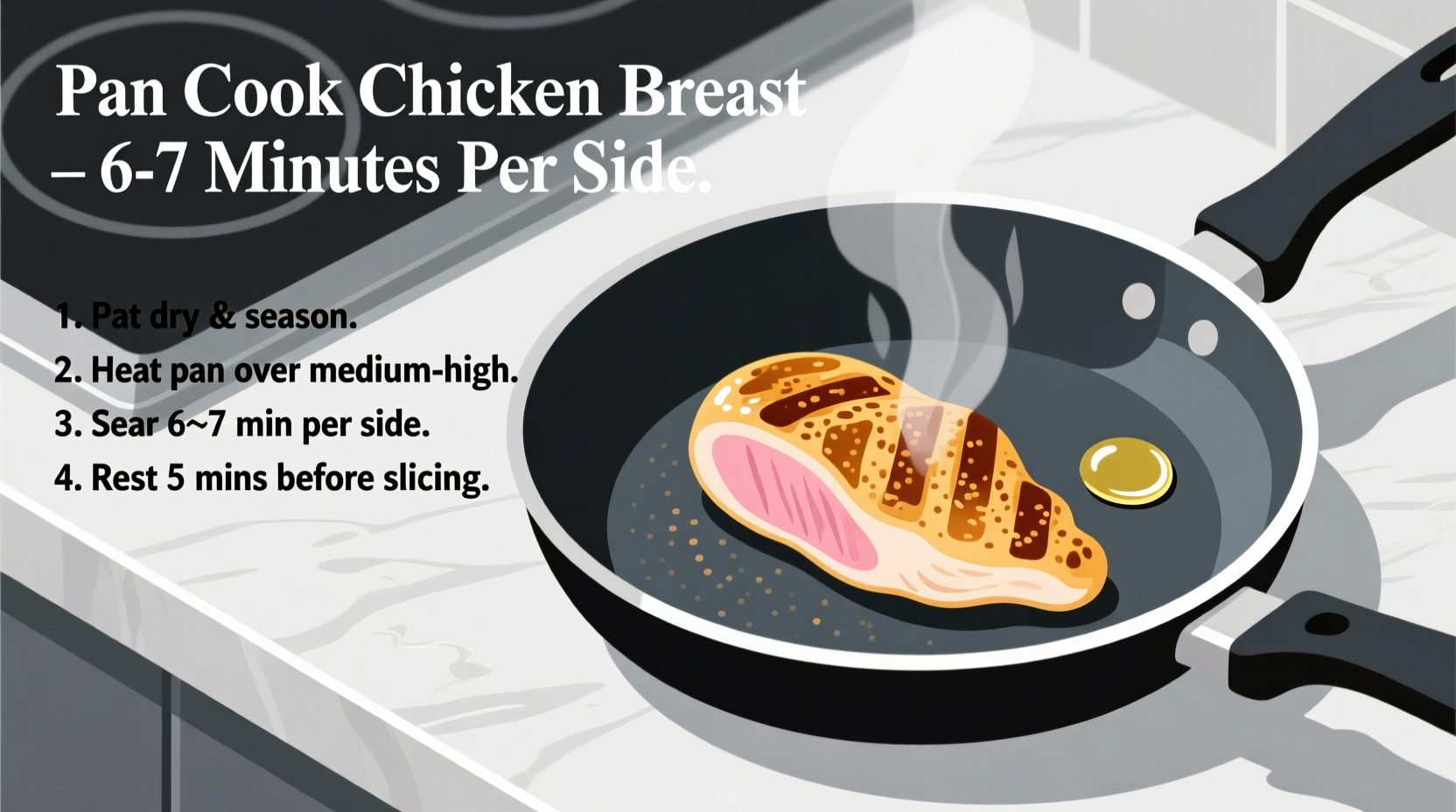Perfect pan-cooked chicken breast takes 10-14 minutes total for standard 1-inch thick cuts: 5-7 minutes per side over medium-high heat until reaching 165°F (74°C) internal temperature. Actual timing varies based on thickness, pan temperature, and starting chicken temperature.
Getting juicy, flavorful pan-seared chicken breast is simpler than you think when you understand the precise timing and technique. Forget dry, rubbery results—this guide delivers restaurant-quality chicken every time with science-backed timing guidelines and professional chef techniques adapted for home kitchens.
Why Precise Timing Matters for Chicken Breast
Chicken breast is notoriously easy to overcook, transforming from succulent to dry in just 30 seconds past optimal doneness. Unlike darker meat, breast contains minimal fat to compensate for timing errors. The USDA's Food Safety and Inspection Service confirms that 165°F (74°C) is the minimum safe internal temperature, but hitting this mark without compromising texture requires exact timing.
| Chicken Thickness | Recommended Cooking Time | Internal Temp Target |
|---|---|---|
| ½ inch (1.3 cm) | 4-5 minutes per side | 160°F (71°C) |
| ¾ inch (1.9 cm) | 5-6 minutes per side | 162°F (72°C) |
| 1 inch (2.5 cm) | 6-7 minutes per side | 165°F (74°C) |
| 1½ inches (3.8 cm) | 8-9 minutes per side | 165°F (74°C) |
Source: USDA Food Safety and Inspection Service temperature guidelines adapted for carryover cooking
The 4-Phase Pan Cooking Process (With Exact Timings)
Phase 1: Preparation (2 Minutes)
- Dry thoroughly with paper towels (critical for proper searing)
- Season with salt 15-30 minutes before cooking (helps retain moisture)
- Bring chicken to near room temperature (15-20 minutes out of fridge)
Phase 2: Pan Setup (1 Minute)
- Use heavy-bottomed skillet (cast iron or stainless steel preferred)
- Heat 1 tbsp high-smoke point oil (avocado or grapeseed) until shimmering
- Test heat: Oil should sizzle immediately when chicken touches surface

Phase 3: Cooking (5-9 Minutes Per Side)
Timing varies significantly based on thickness—use this decision tree:
- Initial sear: Place chicken away from you to prevent oil splatter
- First side: Cook undisturbed 60-70% of total time (5-7 minutes for 1" thick)
- Check release: Chicken should lift easily when properly seared
- Second side: Cook remaining time while monitoring internal temperature
- Final check: Insert thermometer horizontally into thickest part
Critical timing note: Remove chicken at 160-162°F (71-72°C) to account for 5°F (3°C) carryover cooking during rest period. Pulling at exact 165°F (74°C) guarantees overcooking.
When Pan Cooking Isn't Ideal: Context Boundaries
Pan-searing works best for chicken breasts under 1.5 inches thick. For thicker cuts:
- Thicker than 1.5": Start in pan, finish in 375°F (190°C) oven
- Extremely thin cuts: Reduce heat to medium and cook 3-4 minutes per side
- Frozen chicken: Not recommended for pan cooking—thaw first for even results
The American Institute of Chicken Professionals notes that "pan-searing achieves optimal results only when thickness-to-heat ratio is properly balanced"—meaning your timing must adjust for physical variables.
Proven Troubleshooting Techniques
Dry Chicken? You're Overcooking by Just 60 Seconds
Moisture loss accelerates dramatically past 165°F (74°C). Solution:
- Use instant-read thermometer religiously
- Brine thin cuts (½" or less) in 1 cup water + 1 tbsp salt for 30 minutes
- Try reverse searing for thicker cuts: Cook low then sear
Undercooked Center? Your Pan Wasn't Hot Enough
Signs of insufficient heat:
- Excessive steaming instead of sizzling
- Chicken sticks to pan
- Gray band exceeds ¼" at edges
Solution: Preheat pan 3-5 minutes before adding oil. Properly preheated pans create immediate sear that seals in juices.
Essential Food Safety Reminders
The USDA Food Safety and Inspection Service emphasizes these non-negotiables:
- Never partially cook chicken to finish later
- Discard marinades that contacted raw chicken
- Clean surfaces with hot, soapy water after chicken contact
- Refrigerate leftovers within 2 hours (1 hour if room above 90°F/32°C)
Remember: Visual cues alone can't confirm safety. A food thermometer is the only reliable method to verify 165°F (74°C) internal temperature as required by USDA guidelines.











 浙公网安备
33010002000092号
浙公网安备
33010002000092号 浙B2-20120091-4
浙B2-20120091-4